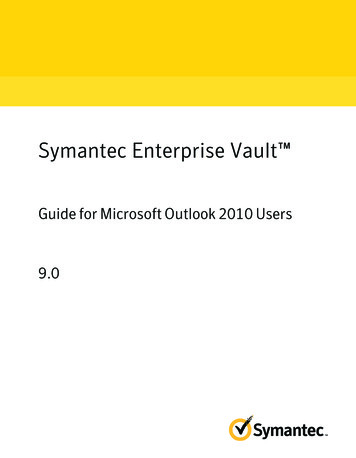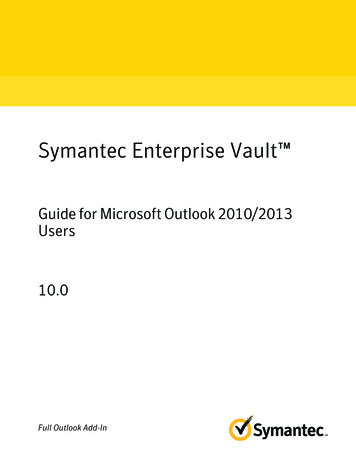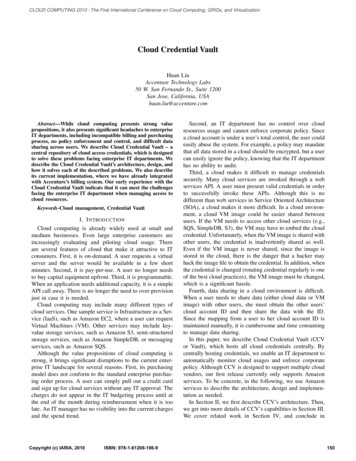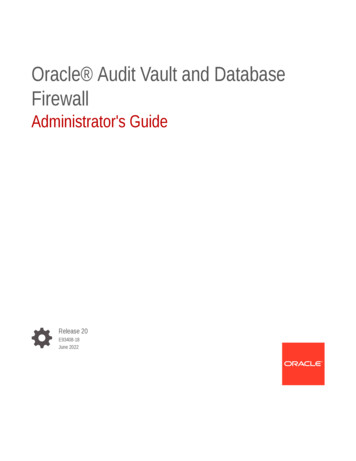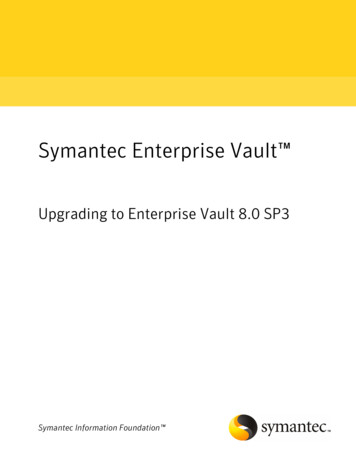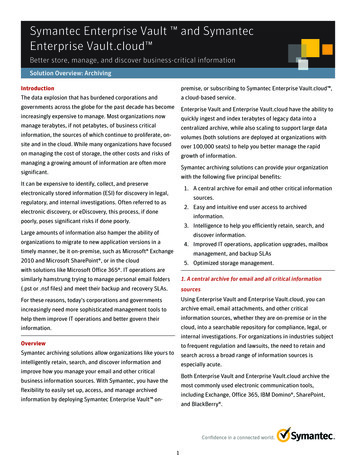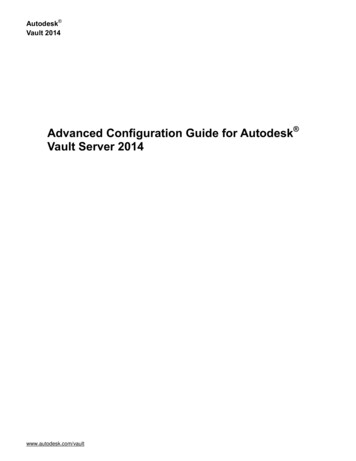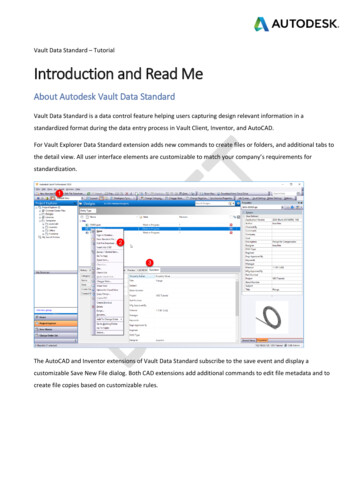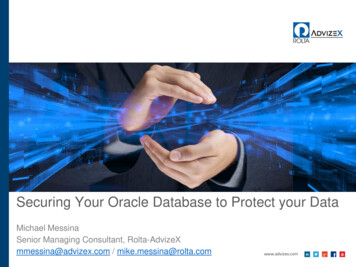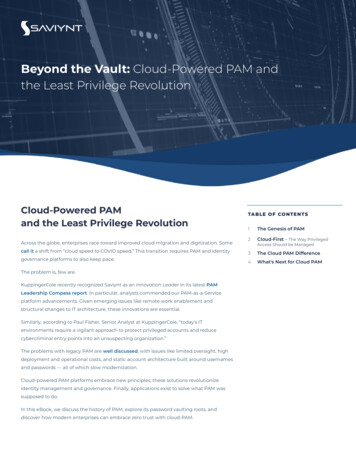
Transcription
Beyond the Vault: Cloud-Powered PAM andthe Least Privilege RevolutionCloud-Powered PAMand the Least Privilege RevolutionAcross the globe, enterprises race toward improved cloud migration and digitization. Somecall it a shift from “cloud speed to COVID speed.” This transition requires PAM and identitygovernance platforms to also keep pace.The problem is, few are.KuppingerCole recently recognized Saviynt as an Innovation Leader in its latest PAMLeadership Compass report. In particular, analysts commended our PAM-as-a-Serviceplatform advancements. Given emerging issues like remote work enablement andstructural changes to IT architecture, these innovations are essential.Similarly, according to Paul Fisher, Senior Analyst at KuppingerCole, “today’s ITenvironments require a vigilant approach to protect privileged accounts and reducecybercriminal entry points into an unsuspecting organization.”The problems with legacy PAM are well discussed, with issues like limited oversight, highdeployment and operational costs, and static account architecture built around usernamesand passwords — all of which slow modernization.Cloud-powered PAM platforms embrace new principles; these solutions revolutionizeidentity management and governance. Finally, applications exist to solve what PAM wassupposed to do.In this eBook, we discuss the history of PAM, explore its password vaulting roots, anddiscover how modern enterprises can embrace zero trust with cloud-PAM.TA B L E O F CO N T E NTS1The Genesis of PAM2Cloud-First – The Way Privileged3The Cloud PAM Difference4What's Next for Cloud PAMAccess Should be Managed
The Genesis of PAMPAM emerged in the 1980s (with Sudo for Unix/Linux), although the first commercial vault didn’t release until the early2000s. Vendors originally created vaults to store passwords for infrastructure. The reason: Every server is built with anadministrator (or ‘root’) account – and these accounts often used the same password when built. Password vaults randomizethese passwords and allow access to each by support teams when needed.Later, broader adoption of password management, active directory bridging, and least privilege solutions occurred. By2007, Privilege Escalation and Delegation Management (PEDM) for Windows appeared, albeit with a focus on endpointslike desktops and laptops. This technology offered better application control and removal of local admin rights. While PEDMtheoretically limits privilege by granting admin rights for particular tasks, applications, or scripts on a limited-basis, it stillrelies on statically defined policy. These rules require manual creation and management. Worse still, they are always in effectfor a user: if a privileged user’s device is compromised, the threat actor obtains the elevated access.Confusion ensued as many began describing these solutions as ‘PAM’, although vaulting remained central. True privilegedaccess management didn’t exist as we experience it today.Outdated PAM Puts Modern IT Ecosystems at RiskConcerningly, enterprises carried these solutions forward – even as ecosystems modernized. See, vaults weredesigned for shared accounts, not personal, application, or web accounts. Personal accounts include a variety ofentitlements that do not lend themselves to management within a vault. Perhaps most concerning is that vaultsdon’t solve a most pressing security issue: excess privileges.Difficulties Delivering Least-Privilege And JITCentralizing privileged accounts in a vault can’t reduce the number of privileged accounts or reduce the risk of theseprivileges. The method won’t guide an enterprise toward principles of least-privilege or just-in-time access, either.
What is . Zero Trust?DEF I NITIONA framework to move from implicit trust to a continuous re-evaluation of riskand trust levels.EXAM PL ESUser VerificationApplying risk-based authentication to validate that every user is who theyclaim to be.Device ValidationEnsuring that only registered devices have access to resources.Intelligent PAMProvisioning users or devices with only as much access as is required, at thetime it is needed.B E NE FITSMovement toward “a workload-first, data-driven, and identity-awaresecurity model.” Additionally, organizations reduce reliance on older legacyapplications and securely re-architect IT environments using newer languagesand designs that can benefit from cloud computing.What is . Just-In-Time Access?D E F IN ITIONAn approach to enforce true “least privilege”–that is, requiring users,processes, applications, and systems to have bare minimum rightsand access to complete a necessary task.EXA M PL E SMonitoring & ManagementTime-bound, automatic provisioning and revocation.Minimizing Standing RiskEnsuring users and systems gain proper access for a limited amountof time within a Privileged Access Management (PAM) softwaresolution.
B E N E F ITSEnforce least privilege strategies by controlling where users canaccess privileged data or accounts – and dictating the actionsthey can perform once they have secured access.As attacks grew, the 2010s saw new defense measures and applications introduced. While robust, the solutions were piecemeal – andballooned enterprises’ architectures. The result: A buffet of SIEM, IGA, SSO, MFA, and Vulnerability Management tools to manage.Although more robust PAM solutions now exist, M&A activity further muddles things. Often, incumbent vendors try to fast-trackinnovation by buying up PAM tools. Here, customers miss out. Fragmented architectures blunt the full potential of PAM. Companiesnow suffer with different consoles, different reporting interfaces, and disparate agents in play.Cloud First – The Way PrivilegedAccess Should be ManagedCloud-first PAM is underestimated as essential to both digital transformationand improved cybersecurity. According to an IDC survey of CISOs, “80% ofleaders cannot identify excessive access to sensitive data in cloud productionenvironments.” Further, “privilege abuse” was the most common actionidentified in over 20,000 incidents reviewed for Verizon’s 2021 Data BreachInvestigations Report.Delivering PAM as a service eliminates a lack of continuous discovery and riskvisibility — a key weakness of legacy solutions.Modern Businesses Demand More Dynamic SecurityEnterprises must be able assess real-time activity among elastic workloads, accounts, and access. For example: Remote workersroutinely use multiple devices to connect to various data and systems. To reduce access misuse, these devices, accounts, andsessions need to be in the real-time purview of security leaders.Further, they must identify risky or misconfigured objects and automatically trigger remediation steps including reversal,exception approval, or quarantine. This is akin to ‘closing the door’ on excessive permissioning — a remedy to the old tactic ofgiving privileged accounts excessive access in the name of ‘simplification.’ Similarly, it addresses the orphaned account issue;those forgotten accounts that sit on the network, primed for misuse.
An added concern is mismanaging vendor, contractor, and other externaluser access. These audiences often need to retrieve privileged data, althoughthey’re seldom managed through standard HR processes.The Cloud PAM DifferenceTo ensure appropriate privilege, PAM must reinforce just-in-time (JIT) principles forcloud access — a core requirement for Zero Trust frameworks. But this is incompatiblewith legacy solutions built on the premise of vaults and credential rotation for privileged –but always-on – access.Further, the manual management is a non-starter to overburdened IT teams. Consider the range of IoT devices, workloads, andother silicon identities in use. Each requires key management and dynamic provisioning of rights to allow for task completionand de-escalation to a safe state. Under this workload, Cloud PAM with automated risk analysis and governance capabilitiesmust be table-stakes.Saviynt recognized the need to remove all standing privileges; for instance, confronting the vaulting of all discoverable,privileged credentials. This dated approach to PAM never reduced the number of privileged accounts, nor limited the risk ofstanding privilege therein. Vaults didn’t solve the problem; they centralized it.With Cloud PAM, Saviynt allows organizations to remove these accounts and incorporate least-privilege principles. Using ajust-in-time approach to privileged access, end users receive the right level of privilege for their immediate task — across allassets, applications, and platforms. This is why Saviynt designed a cloud PAM platform with Zero Trust, zero-standing privilege,and JIT access at the center. Without an on-prem footprint, the platform adds versatility: secure privileged access and criticalasset protection across the entire infrastructure.
What's Next For Cloud PAMAs PAM progresses, we believe that the 2020s will be about consolidation and simplicity. A true cloud PAM solution isconverged. This means integrated IGA and PAM capabilities.For example, the Saviynt platform works inside the cloud to attach rights and privileges to identities to streamline governance– no bolt-on software required. In contrast, traditional PAM focuses on infrastructure. Cloud PAM leapfrogs this with built-inconnectors, bringing JIT to applications and consoles. And rather than creating additional user accounts for privileged accessthat need monitoring, administrators can assign time bound permissions to identities.Explicitly managed privileged access hardens corporate security postures in a variety of ways. First, enterprises establisha well-defined access audit trail. Usage monitoring allows machine learning algorithms to identify anomalous behavior,where breaches are detected before attackers can reach the inner IT ecosystem. Saviynt’s Cloud PAM solution also consumesconfiguration data from popular cloud platforms to provide insights into security and risk-prone configurations.These innovations extend governance. Sure, existing solutions may tell administrators who has access to what. But convergedsolutions broaden this. Not only do they certify access, but they manage the lifecycle of the user and the privilege. They shouldalso be able to govern the machine a user uses and what access they have – even down to granular entitlements.We’ve come a long way since the days when PAM was a fancy term for password vaulting. Today, PAM offers more: Simplified onboarding and management Alignment to zero standing privileges for infrastructure, applications, and web apps JIT access to infrastructure, applications, and web apps Real-time discovery and onboarding of dynamic cloud workloads Governance-driven risk insights and reporting of cloud security For enterprises that want improved security controls and operational disciplines – and want simpler,more robust identity and privilege control, there is a solution.For enterprises that want improved security controls and operational disciplines – and want simpler, morerobust identity and privilege control, there is a solution.Rarely can goals like these be solved with a single offering. But sometimes, rarely actually exists.See why customers and analysts are excited about Saviynt. Explore our CPAM solution today.Learn more
Saviynt is the leading identity governance platform built for the cloud. It helps enterpriseWant to talk to an identity andcustomers accelerate modern cloud initiatives and solve the toughest security and compliancesecurity expert?challenges in record time. The Saviynt Enterprise Identity Cloud converges IGA, granularapplication access, cloud security, and privileged access into the industry’s only enterprisegrade SaaS solution. Learn more at saviynt.com.Schedule a Call Today
Beyond the Vault: Cloud-Powered PAM and the Least Privilege Revolution Cloud-Powered PAM and the Least Privilege Revolution. PAM emerged in the 1980s (with Sudo for Unix/Linux), although the first commercial vault didn't release until the early . The method won't guide an enterprise toward principles of least-privilege or just-in-time .


